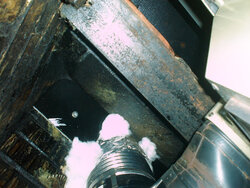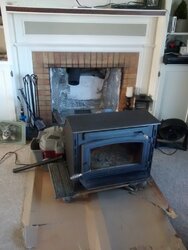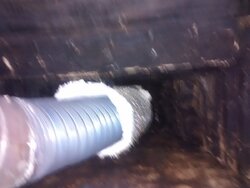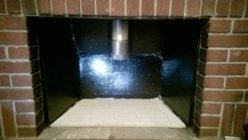Let e start off by saying my primary heat is the woodstove. I have aforced air unit but choose to heat with wood. I have installed a woodstove insert into an existing fireplace. The chimney is an exterior masonry chimney.
I installed a stainless steel liner from the wood stove to the top of the chimney. Furthermore I insulated the flue with vermiculite and added the chimney cap. So no heat will escape up the chimney except what goes up inside the liner.
Now the smoke chamber of the existing fireplace gets extremely hot. And this is is the area I want to re-purpose. I want to bring that heat into the living space. So I have devised a plan to bring that air back into the living space. I have decided not to remove any of the bricks from the fireplace thus potentially waking the structure.
I will add some heat saver rings to the stainless steel liner located in the smoke chamber. This will radiate even more heat in the smoke chamber. I plan to add twould 6" inline duct work fans and force the air from the smoke chamber back into the living space.
That's the overall plan.
First though I have to prep to smoke chamber. I suspect that if i dont coat the walls theni will haveunwanted odors being pulled back in the room. I have already wire brushed and vacuumed the smokechamber.. Now I have to choose a product to coat the smoke chamber. The fire chamber is in decent shape. Their are a couple of ways I can do this. I can parge the smoke chamber with a product called ahrens chamber tech 2000. Or I can use high temp paint to seal in the odors. Just wondering if anyone has any thoughts on which product use.
I'm thinking high temp paint.
I installed a stainless steel liner from the wood stove to the top of the chimney. Furthermore I insulated the flue with vermiculite and added the chimney cap. So no heat will escape up the chimney except what goes up inside the liner.
Now the smoke chamber of the existing fireplace gets extremely hot. And this is is the area I want to re-purpose. I want to bring that heat into the living space. So I have devised a plan to bring that air back into the living space. I have decided not to remove any of the bricks from the fireplace thus potentially waking the structure.
I will add some heat saver rings to the stainless steel liner located in the smoke chamber. This will radiate even more heat in the smoke chamber. I plan to add twould 6" inline duct work fans and force the air from the smoke chamber back into the living space.
That's the overall plan.
First though I have to prep to smoke chamber. I suspect that if i dont coat the walls theni will haveunwanted odors being pulled back in the room. I have already wire brushed and vacuumed the smokechamber.. Now I have to choose a product to coat the smoke chamber. The fire chamber is in decent shape. Their are a couple of ways I can do this. I can parge the smoke chamber with a product called ahrens chamber tech 2000. Or I can use high temp paint to seal in the odors. Just wondering if anyone has any thoughts on which product use.
I'm thinking high temp paint.





